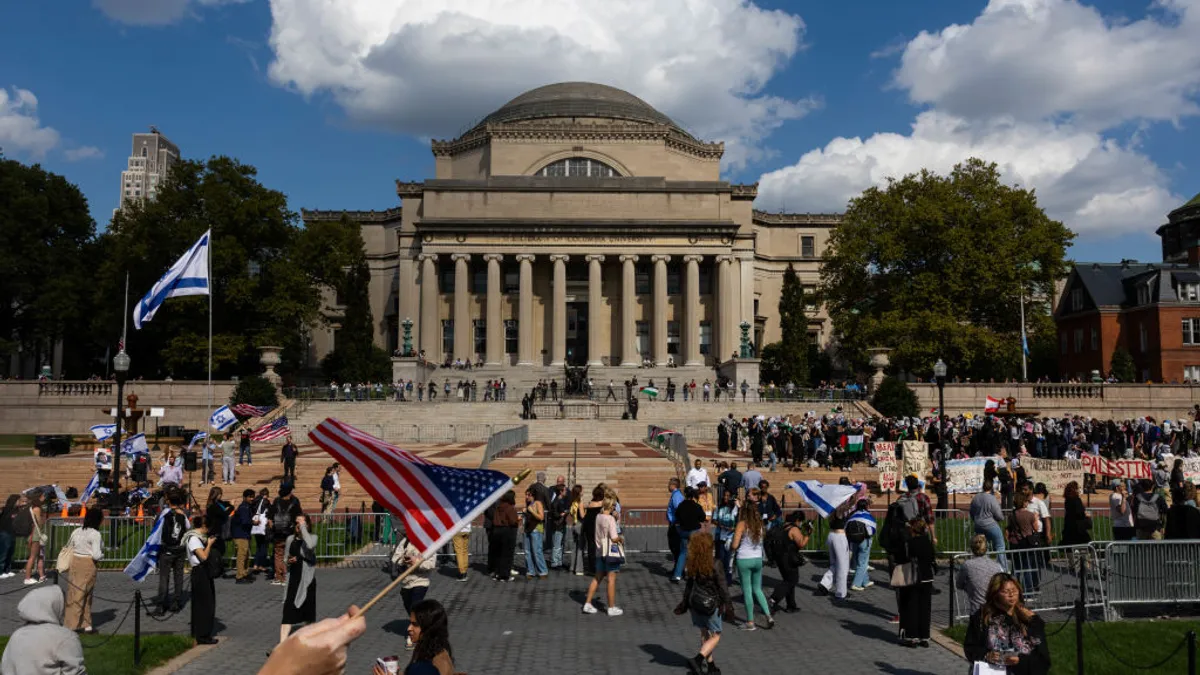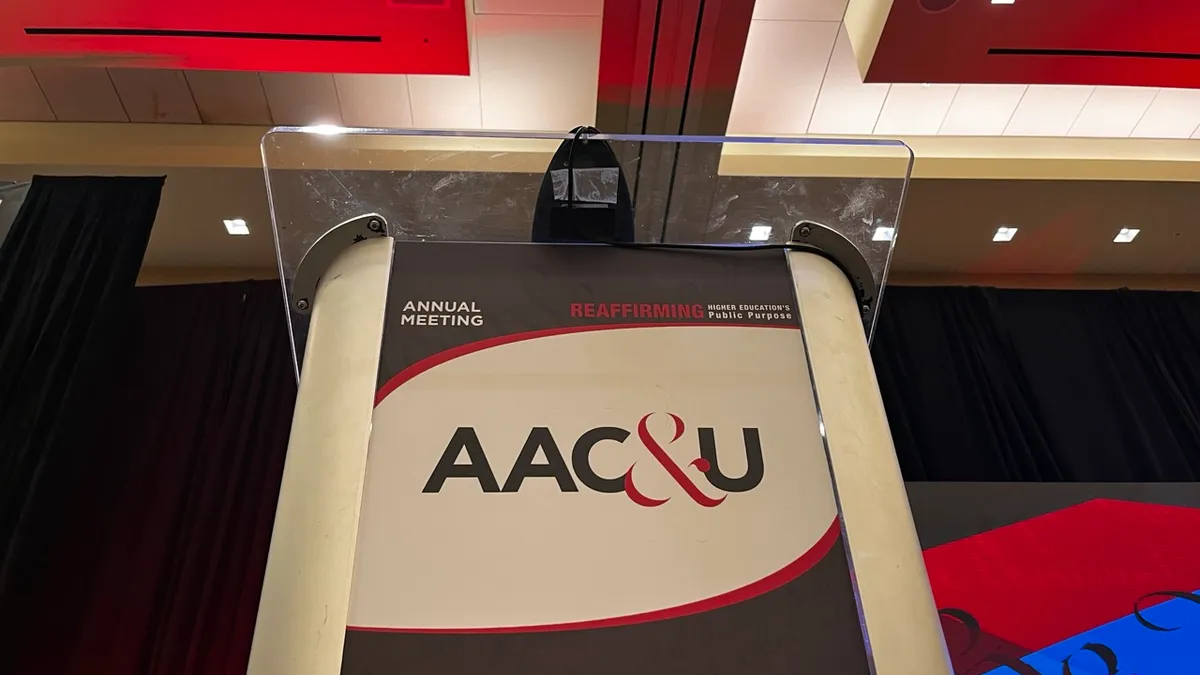In a year when higher education athletic departments slashed budgets and dropped teams, one university is going a step further.
The University of Hartford in early May said it would transition its athletics programs from Division I to Division III. Officials at the time said the school would be able to "strengthen the academic, co-curricular, and wellness experience for all students" as a result of the move, which a feasibility study they commissioned said could save more than $9 million a year.
The same day Hartford announced its change, the University of California, Riverside, said it would continue offering its 17 DI teams. The decision came as a relief to student-athletes, department staff and other supporters, as the public university had debated ending varsity sports to help balance its budget in light of the pandemic's financial impact.
UC Riverside instead is considering other ways to stabilize its finances, such as by raising students' $105 athletics fee for the first time in 20 years.
Hartford and UC Riverside join many colleges across the country that are contemplating, and in some cases executing, major changes to athletics programming at a time when institutional budgets are getting squeezed on all sides.
Some higher ed sports experts say the crisis could have been a catalyst, pushing colleges strained by their athletics commitments to fundamentally alter their approach to sports. But few schools are likely to go to such lengths, they say. One reason is that the changes would be extensive and also would require them to contend more directly with ongoing concerns about their compliance with Title IX.
"If there was a moment when schools might have been able to do this," said Ellen Staurowsky, a professor of sports media at Ithaca College, "it would have been in this time period."
Drop divisions or grow in place?
Changing divisions is something of a last resort for colleges looking to right their finances, said Donna Lopiano, a sports management consultant and president of college sports ethics watchdog The Drake Group. That's partly because such a change could cause schools to lose touch with some of their athletics history. "It's a big deal," Lopiano said.
In a statement emailed to Higher Ed Dive, a Hartford spokesperson said the pandemic did not drive its decision. Instead, the spokesperson recited a litany common these days among smaller colleges making big changes: heavy competition, declining numbers of traditional-age prospective students, concerns about the rising cost of attendance and the impact of student debt.
Hartford will formally notify the NCAA of its intent to switch divisions in January 2022. If the NCAA approves, the university expects to be in DIII by September 2025. In the meantime, it will stop offering scholarships to incoming student-athletes starting in the 2022-23 academic year.
B. David Ridpath, a sports business professor at Ohio University, is optimistic about what the move could mean for Hartford in the long term. Dropping scholarship sports, he said, could let it field more teams, helping to grow enrollment and, as a result, tuition revenue.
Scholarships aren't the only expense that goes away with the shift to DIII. Top division programs tend to spend more on their teams than lower divisions, though only the most prominent draw in enough outside revenue to justify the costs. Smaller and less-eminent DI programs rely more heavily on institutional support, including from student fees, to close that gap.
UC Riverside's athletics department, for instance, is the most heavily subsidized in DI, per a USA Today analysis of 2018-19 finances.
"I don't believe that having the Division I moniker is as important as many schools want to believe that it is," said Ridpath, who is also past president of The Drake Group.
Ridpath thinks many schools are holding out on changing divisions because they think being DI offers a kind of premium status. There's also the hope of winning a national championship and the public relations boon that would bring. But he doesn't think Hartford's decision, which comes on the heels of an NCAA championship berth for its men's basketball team, indicates a rash of divisional changes to come.
"If there was a moment when schools might have been able to do this, it would have been in this time period."

Ellen Staurowsky
Professor of sports media, Ithaca College
Growing within DI during the pandemic was a strategic choice for Fairleigh Dickinson University, said Jason Young, its associate athletic director for external affairs. The private New Jersey university is adding two sports to the lineup at its Metropolitan campus: men's volleyball and women's lacrosse. Young called the additions "a statement on the direction of the university," adding that athletics could "drive that message forward."
Young offered a few reasons why: Many students at Fairleigh Dickinson commute to campus, whereas student-athletes make up a large share of those living in the dorms and the school has space there for more of them. The two new programs are popular at high schools in the region. And its other U.S. campus, also in New Jersey, already offers DIII sports.
"I'm a huge proponent of this idea that you can be Division I and you can do it in a sound financial way," Young said. "I also think every campus has to be looked at uniquely."
Title IX and the impact of cuts
Divisional changes may be rare during the pandemic, but cuts to entire teams have been more frequent. More than 350 NCAA sports programs were cut between March and November of 2020, ESPN reported, though the number includes programs that have since been revived.
Many schools have drawn backlash over the decisions, with some observers arguing that eliminating teams only highlights, rather than corrects, deep flaws with how colleges comply with Title IX, the federal law banning sex-based discrimination on campuses. The attempted cuts also come amid intensified scrutiny of how the country's biggest companies and institutions approach racial and gender equity, and as student-athletes press for more rights.
Stanford University in mid-May reversed plans to cut 11 varsity sports — nearly a third of its athletic programs. In a statement, the California university's president said "vigorous and broad-based philanthropic interest" from alumni "convinced" officials they would be able to raise money to support the programs.
Virginia's William & Mary similarly reinstated seven teams it planned to discontinue. School officials announced the cuts in September and said they were designed to help address budget pressures. But following strong opposition from alumni and other advocates, including the possibility of a Title IX lawsuit, the school changed course in the following weeks, bringing back three women's sports in direct response to the lawsuit and temporarily reviving four men's teams. Officials said the reversal bought them time to work out a new solution, The Virginian-Pilot reported.
Dartmouth College also reinstated five teams through at least 2024-25 under threat of a Title IX lawsuit.
Several schools have attracted legal action and other criticism for their plans to eliminate varsity teams during the pandemic, The Washington Post reported in March. Some argue the schools are violating Title IX by eliminating opportunities for women, though cuts to men's teams have also landed in the Title IX compliance spotlight.
"Athletics doesn't have its act in gear in terms of regularly assessing compliance, addressing compliance," something pandemic-related budget pressures highlighted, Lopiano said. The visibility of schools getting sued could make others take a harder look at compliance, she added, though she's skeptical this crisis will lead to broader change.
The cuts' impact on racial diversity also has been a focus. Some schools made assurances officials had considered how the cuts would affect opportunities for students of color. But "part of the pushback that came roaring back ... was that they clearly hadn't," Ithaca's Staurowsky said.
Brown University reinstated its men's track and field and cross country teams after news of their elimination, along with eight other programs in response to an earlier Title IX settlement, raised concern the move would hurt campus diversity. Supporters of keeping the teams argued the sports were among the most racially diverse at the institution and within the NCAA, which the university's president publicly acknowledged.
Clemson University's move to nix men's track and cross country also drew concern that the absence of those sports would limit opportunities for Black athletes, in particular — and that other colleges would try to eliminate the teams as way to settle Title IX disputes involving women's programs.
Fears about the impact on campus diversity also reared in response to Stanford's cuts. One student analysis showed they would disproportionately affect Asian American and first-generation/low-income students.
Eliminating teams should be a last resort for colleges, Lopiano said. Such decisions draw negative publicity and risk losing alumni donors, she noted, adding that there are other ways to reduce expenses, such as putting teams in different financial tiers.
"I know of no university in the country who says, 'I'm going to treat all my academic departments equally.' They make choices all the time in education," Lopiano said. "And somehow, athletics is immune from that kind of responsibility?"






















